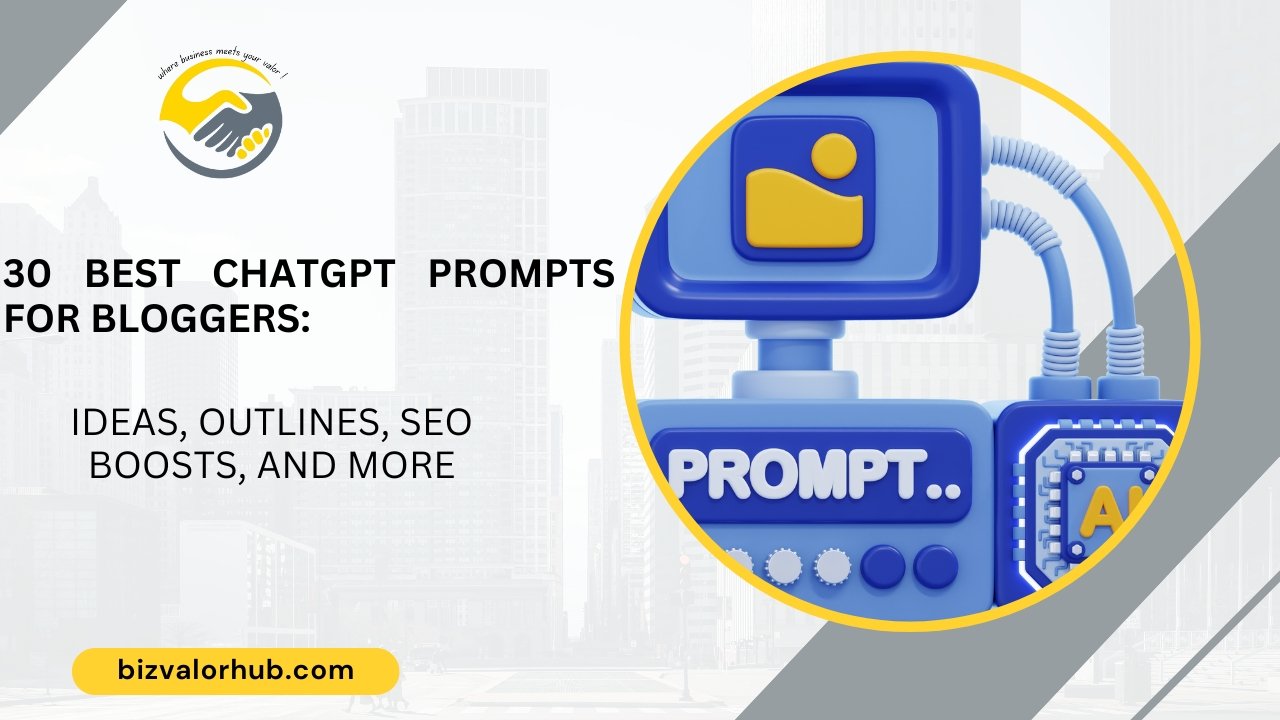Using ChatGPT for blog posts can seriously make your life easier when it comes to grabbing readers’ attention and climbing those search rankings. It’s like having a turbocharged assistant that helps you whip up SEO-friendly content in no time. The trick is knowing how to use it smartly—not to replace your voice but to work alongside it. Think of ChatGPT as your brainstorming buddy, handling the grunt work while you add the magic touch that connects with your audience and keeps search engines happy. This guide will help you use ChatGPT for blog posts that don’t just exist—they stand out.
💡Key Takeaways :
To use ChatGPT for blog posts, start with clear prompts to brainstorm ideas, generate outlines, and suggest keywords. Optimize content by refining tone, ensuring readability, verifying accuracy, and aligning with SEO goals like E-E-A-T. Always edit and add a personal touch for originality, creating engaging, search-friendly posts.
Tip#1. Leveraging ChatGPT for Blogging Ideas
One of the most significant benefits of using ChatGPT is its ability to generate compelling blog post ideas. It can help you brainstorm topics that are relevant to your target audience and aligned with your overall content strategy.
To leverage ChatGPT for idea generation, simply provide it with a few keywords related to your niche and ask it to suggest some blog post topics. For example, if you run a website about fitness, you could ask ChatGPT: “Give me some ideas for blogging about fitness for beginners.” ChatGPT will then provide you with a list of potential topics such as:
✅Beginner’s Guide to Weightlifting
✅Easy Exercises for Beginners
✅How to Stay Motivated When Starting a Fitness Journey
In addition to suggesting topics, ChatGPT can also provide you with outlines for your blog posts. This can save you a lot of time and help you to stay organized.
Here are some tips for using ChatGPT to brainstorm blogging ideas:
- Be specific about your target audience.
- Provide ChatGPT with as much information as possible about your niche.
- Don’t be afraid to experiment with different prompts.
Tip#2. Writing Attention-Grabbing Blog Openings with ChatGPT
A captivating introduction is crucial to grab your readers’ attention and entice them to continue reading. ChatGPT can be a valuable tool in crafting compelling introductions that set the tone for your blog post and pique interest. Here’s how:
- Start with a Hook: Use ChatGPT to generate attention-grabbing opening lines. This could be a thought-provoking question, a surprising statistic, or a compelling anecdote.
- State Your Main Point: Clearly communicate the main theme or argument of your blog post in the introduction. ChatGPT can help you formulate a concise and impactful thesis statement.
- Preview Key Points: Briefly mention the key points you will be discussing in the blog post to give readers a roadmap of what to expect.
Tip#3. Optimizing Content for Search Engines with ChatGPT
Once you have a solid foundation for your blog post, it’s time to make sure it’s optimized for search engines. This is where ChatGPT’s capabilities truly shine. With a few simple prompts, you can ask ChatGPT to generate relevant keywords and incorporate them naturally into your content. For example, you can ask ChatGPT to “suggest relevant keywords for the topic [topic of your blog post]” or “rewrite this paragraph to incorporate the keyword [keyword]”.
In addition to keywords, ChatGPT can also help you optimize your content for readability and search engine crawlers. Ask ChatGPT to:
- Summarize your content in a concise and engaging way.
- Rewrite your content to make it more readable.
- Generate relevant headings and subheadings that break up your content and make it easier to scan.
Remember, the goal of optimization is to create content that is both valuable to your audience and easily understood by search engines. By using ChatGPT strategically, you can achieve both and ensure your blog posts are seen by the right people.
| Task | Description |
|---|---|
| Keyword Generation | Use prompts like “suggest relevant keywords for the topic [topic of your blog post]” or “rewrite this paragraph to incorporate the keyword [keyword]”. |
| Content Optimization |
|
Tip#4. Fine-Tuning ChatGPT Output for SEO
While ChatGPT can generate compelling content, it’s crucial to refine its output to ensure it aligns with your specific needs and targets your desired audience. Think of ChatGPT as a starting point, not a finished product. Here’s how you can fine-tune its output for SEO:
- Check for Accuracy and Relevance: Review the generated content for factual correctness and relevance to your blog’s theme and target audience. ChatGPT can sometimes produce inaccurate or irrelevant information, so it’s important to verify its output before publishing.
- Refine the Tone and Style: While ChatGPT can adapt its writing style, it might not perfectly match your blog’s voice. Make sure the tone and style are consistent with your brand and resonate with your readers.
- Add Human Touch: Infuse your unique perspective, personal anecdotes, and insights into the ChatGPT-generated content to make it more engaging and authentic. Consider using ChatGPT as a springboard to brainstorm additional ideas and perspectives.
- Proofread and Edit: Even with its impressive abilities, ChatGPT can still make grammatical errors or miss nuances in language. Always proofread and edit the output for clarity, accuracy, and flow.
By following these steps, you can leverage ChatGPT’s capabilities to create high-quality blog posts that rank well and engage your audience.
Tip#5. Creating Detailed Blog Outlines with ChatGPT
Using ChatGPT to create comprehensive blog outlines can streamline your content planning process and establish topical authority. Begin by inputting a well-structured prompt such as, “Generate a detailed outline for a blog post about [topic], including key sections and subtopics.” This ensures ChatGPT produces an organized framework, incorporating primary and secondary keywords naturally.
A strong outline aids in covering related subtopics that signal expertise and relevance to search engines. Including essential elements like questions, examples, and data points in your outline further supports EEAT principles by showing depth and trustworthiness. Outlining with ChatGPT helps position your content strategically, meeting user search intent while fostering a logical flow that enhances reader engagement.
Tip#6. Generating Keywords and LSI Terms
Optimizing your blog posts starts with selecting the right keywords and integrating LSI (Latent Semantic Indexing) terms that enrich your content. With ChatGPT, you can streamline this process by generating focused keyword lists and related terms. Here’s how to do it effectively:

- Keyword Research Prompt: Use ChatGPT to brainstorm main keywords by prompting it with, “What are high-traffic keywords for [topic]?” This helps align your content with popular search queries.
- LSI Term Identification: Generate LSI terms by asking, “List related terms or phrases for [keyword].” These terms broaden your content’s reach and relevance, enhancing topical authority.
- Strategic Placement: Naturally integrate these keywords and LSI terms throughout your headings, subheadings, and body content to maintain readability while signaling relevance to search engines.
- SEO Consistency Check: Ensure the use of keywords aligns with your overall SEO strategies and avoids overstuffing. Use tools or manual review to balance density effectively.
By leveraging these techniques, you ensure your blog maintains its topical authority and meets search intent effectively, positioning it for better visibility and reader engagement.
Tip#7. Adding Frequently Asked Questions (FAQs)
Incorporating an FAQ section in your blog posts is an effective way to address common queries, enhance topical depth, and improve search visibility. ChatGPT can assist in generating relevant questions and answers to elevate your content’s usefulness. Here’s how to add FAQs effectively:
- Identify User Intent: Prompt ChatGPT with questions like, “What are the most common questions readers ask about [topic]?” to find FAQs that align with user search intent.
- Generate Concise Answers: Ensure answers are clear, informative, and accurate, using ChatGPT-generated responses as a base. Fact-check for EEAT compliance to maintain credibility.
- Integrate Keywords: Weave primary and secondary keywords naturally into FAQs to reinforce your blog’s SEO without keyword stuffing.
- Rich Snippets Optimization: Format FAQs using schema markup to increase the likelihood of appearing in Google’s featured snippets, boosting organic traffic.
By strategically adding FAQs, you can increase topical authority, address search intent directly, and enhance user experience, all while improving your blog’s SEO performance.
Tip#8. Reviewing and Refining Blog Content with ChatGPT
To ensure your blog content meets high standards for accuracy and engagement, use ChatGPT as a tool for iterative refinement. Leveraging AI for content review helps maintain topical authority and align with SEO practices. Here’s how:
- Request Feedback on Structure: Use ChatGPT prompts like “Review my blog content for logical flow and coherence.” This helps pinpoint areas that may need clearer transitions or improved organization.
- Enhance Readability: Ask ChatGPT for suggestions to make complex sections more reader-friendly. This supports better user engagement and reflects well on your EEAT (Experience, Expertise, Authority, Trustworthiness).
- Optimize for Keywords: Refine your content by prompting ChatGPT to suggest alternative phrasing for incorporating primary and LSI keywords, maintaining a natural flow while improving SEO.
- Fact-Check with a Human Review: While ChatGPT can enhance language and style, pair it with manual verification to ensure accuracy, reinforcing your content’s reliability and topical authority.
By systematically reviewing and refining your content with ChatGPT, you can improve its quality, maximize SEO potential, and provide a valuable reading experience that aligns with search intent and EEAT principles.
Use ChatGPT to Write Blog Posts Conclusion
In conclusion, using ChatGPT to write blog posts can revolutionize your content creation process. By harnessing its ability to generate ideas, craft compelling introductions, optimize content for search engines, and streamline the writing process, you can create high-quality blog posts that captivate your audience and drive traffic to your website.
Remember that ChatGPT is a valuable tool but not a substitute for human creativity and judgment. Use it to spark inspiration, enhance your workflow, and elevate your content, but always ensure you’re refining its output, adding your unique voice, and maintaining the integrity of your brand and message. By strategically integrating ChatGPT into your content creation process, you can unlock new possibilities, boost your online presence, and achieve your content marketing goals.
Use ChatGPT to Write Blog Posts Quick FAQ
1. Is ChatGPT a replacement for human writers?
ChatGPT is a powerful tool for content creation, but it’s not a replacement for human writers. It can generate ideas, outlines, and even draft content, but it lacks the nuanced understanding of human experience, creativity, and critical thinking. Think of ChatGPT as a collaborative partner, enhancing your writing process rather than entirely replacing it.
2. How can I ensure my blog posts are unique and original when using ChatGPT?
ChatGPT’s output is based on its training data, so there’s a chance of overlap with existing content. To ensure uniqueness, always refine ChatGPT’s output with your own voice, insights, and personal experiences. Focus on adding value beyond the generated text by offering unique perspectives, in-depth analysis, and relevant case studies.
3. What are the limitations of using ChatGPT for blog post creation?
ChatGPT is still under development, and it may not always provide accurate or relevant information. It can also struggle with complex topics and may require additional research and fact-checking. It’s crucial to use ChatGPT responsibly and critically assess its output before publishing.
4. Is it legal to use ChatGPT to write a blog?
Yes, using ChatGPT to write a blog is legal. AI-generated content can be utilized for blogging as long as it doesn’t violate copyright laws or platform policies. To maintain quality and align with Google’s guidelines for expertise, experience, authority, and trustworthiness (EEAT), it’s vital to review and fact-check content. Adding personal insights ensures originality and enhances reader trust. Always verify AI outputs for accuracy and relevance before publishing to maintain high content standards.









